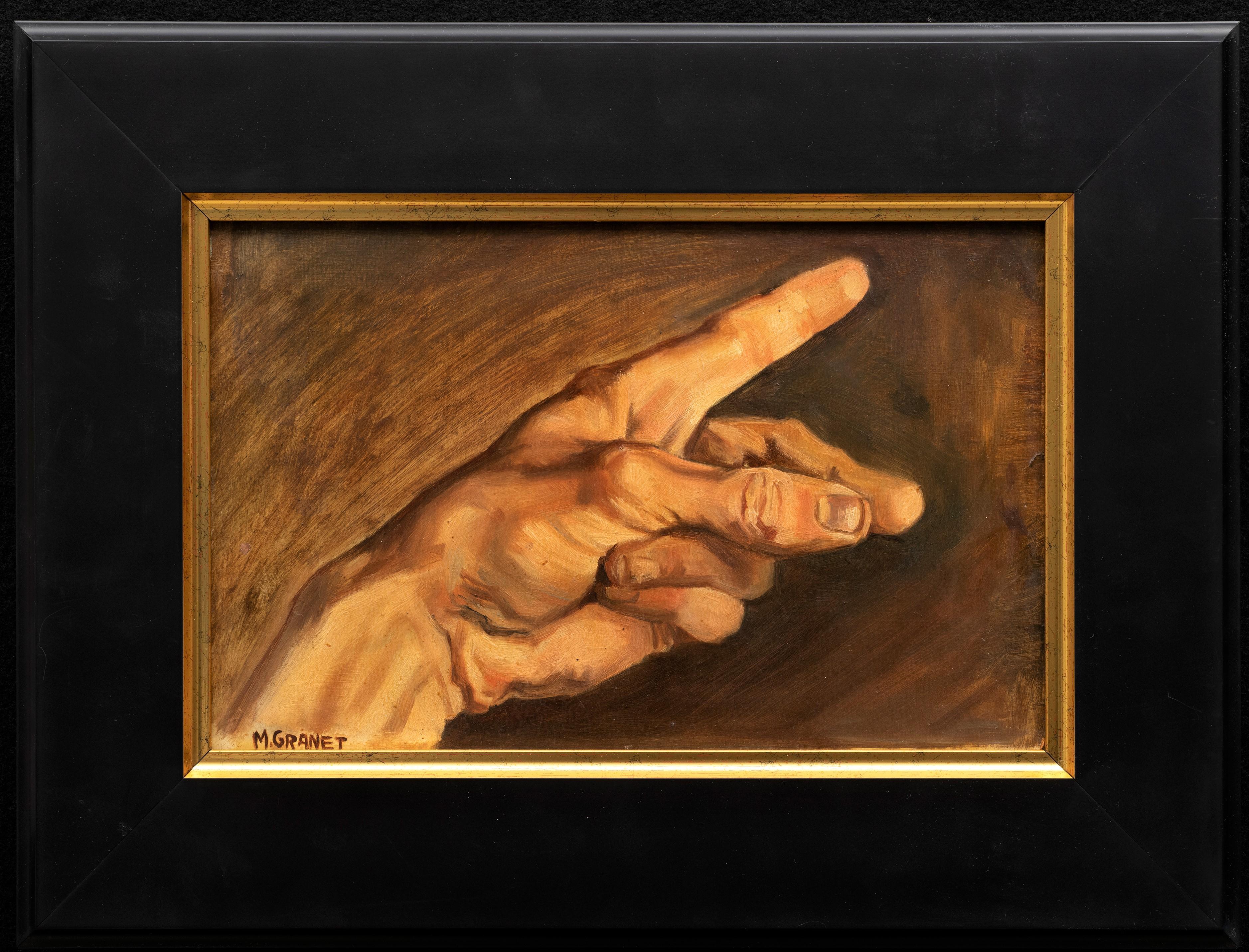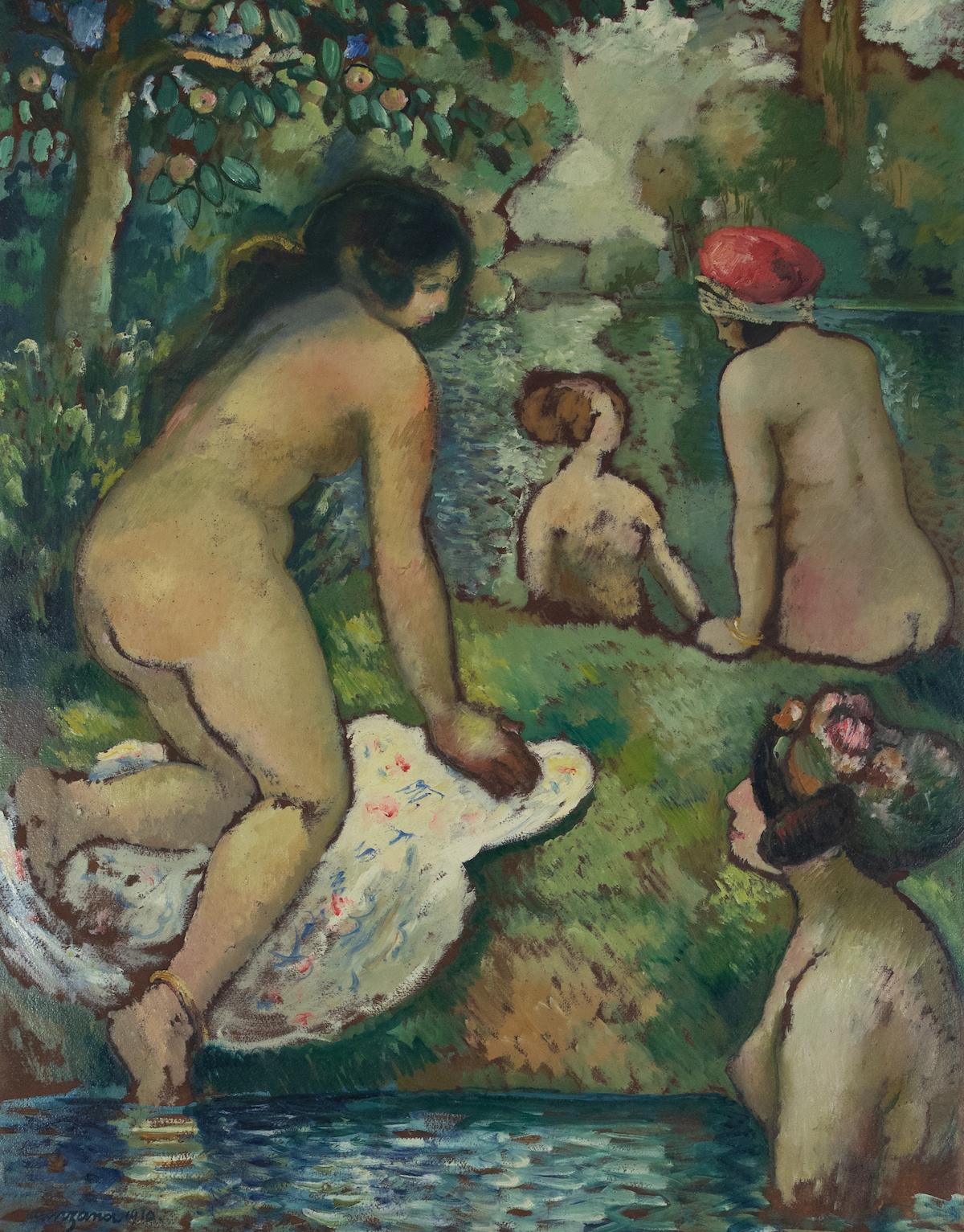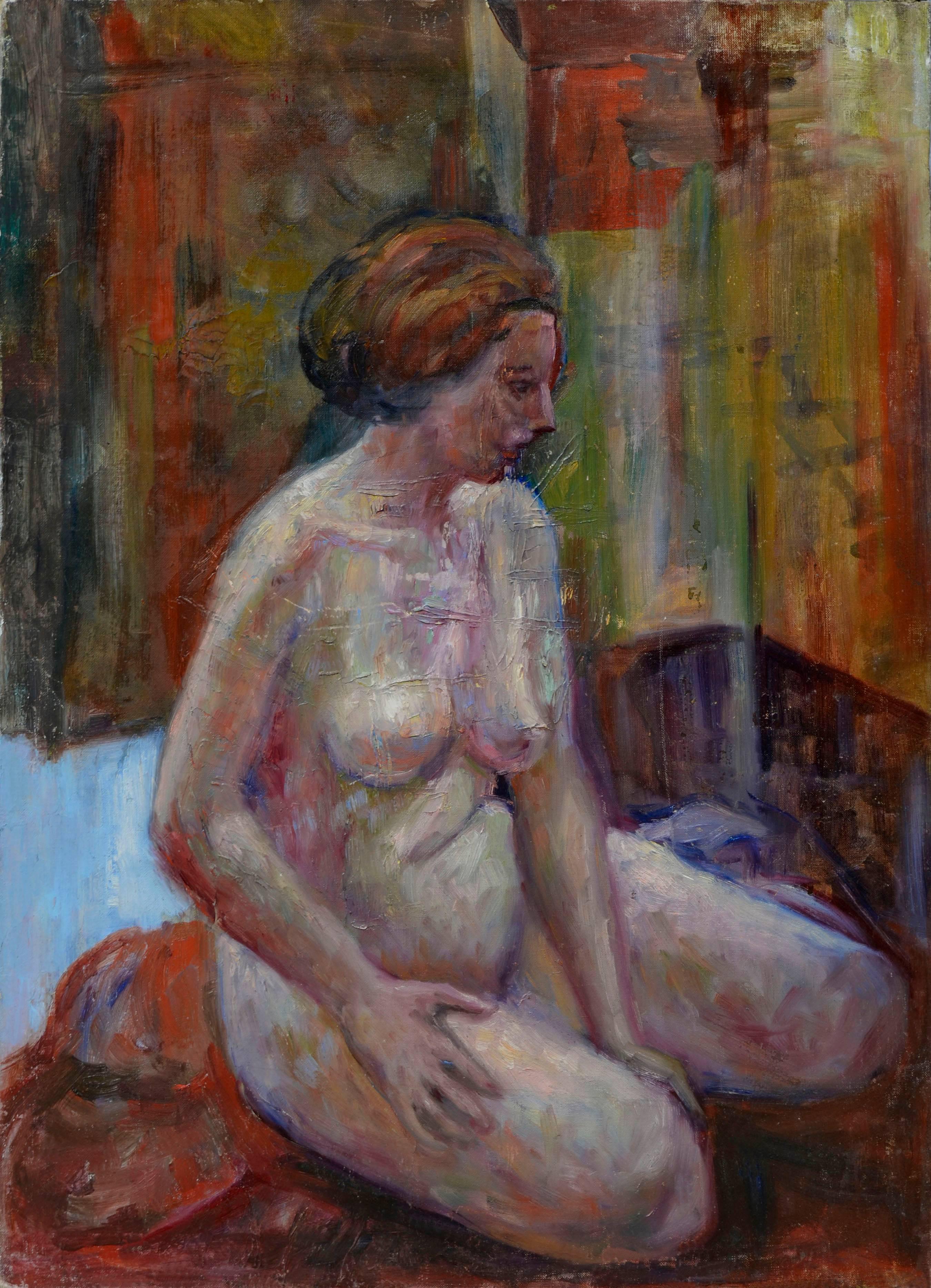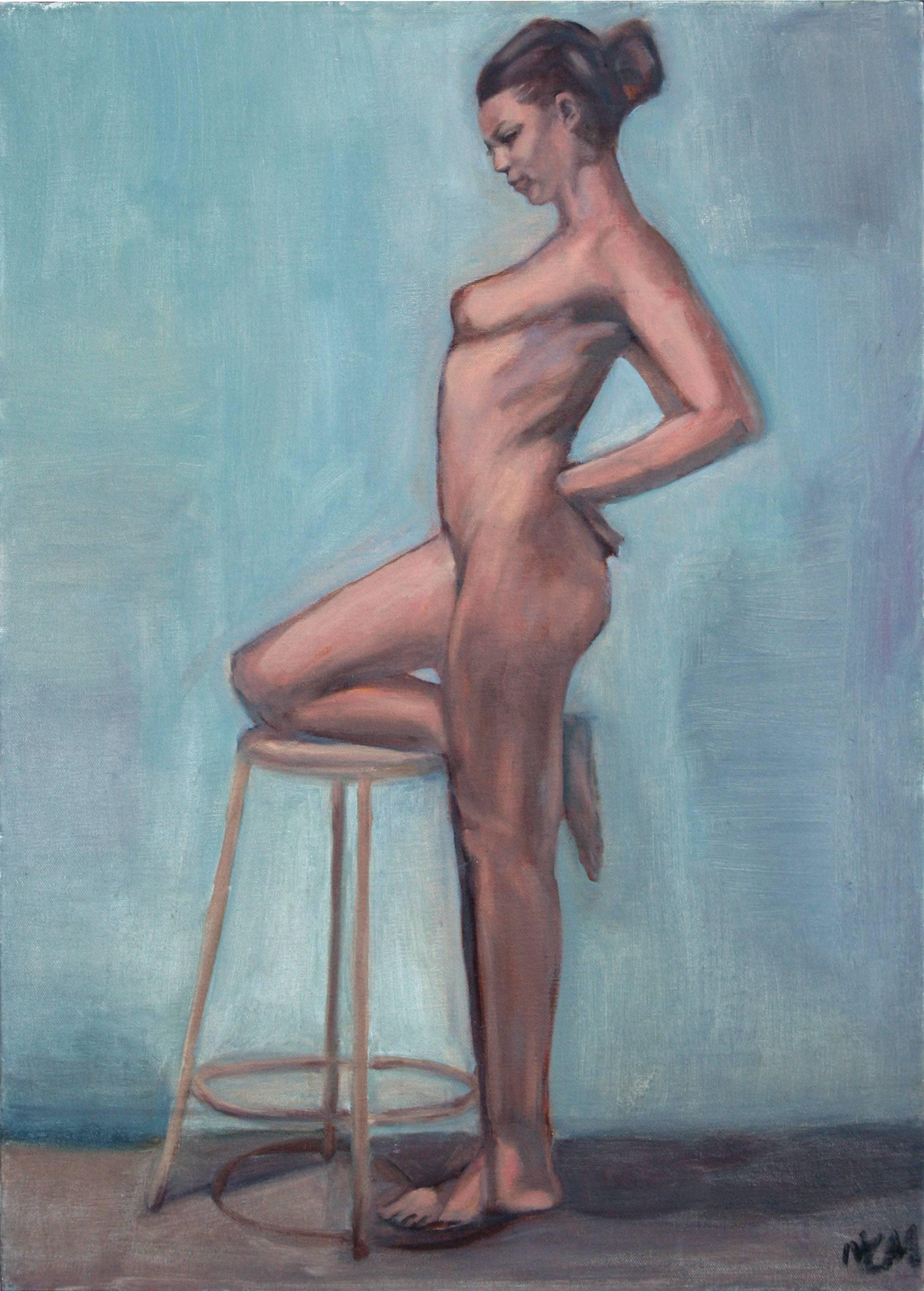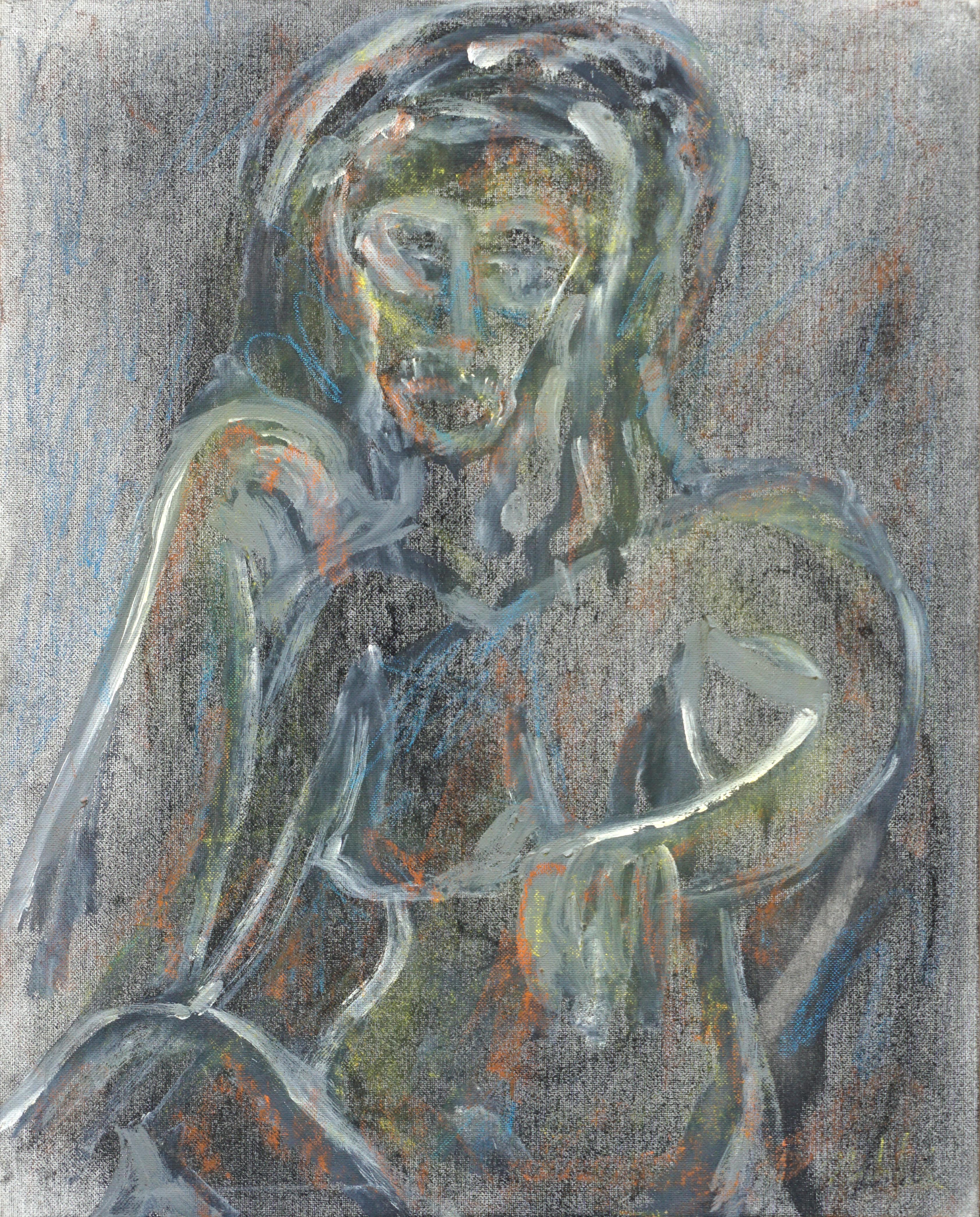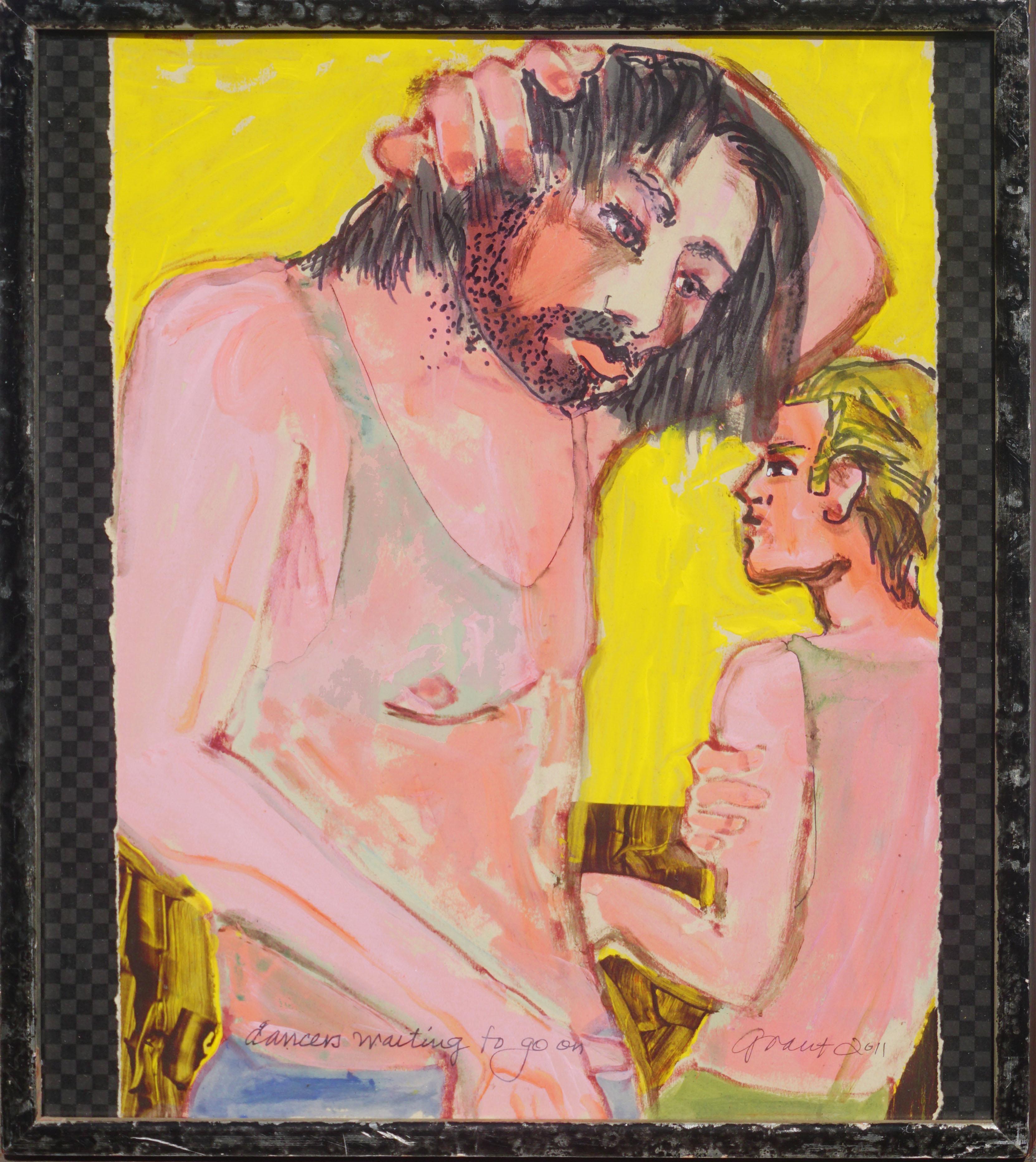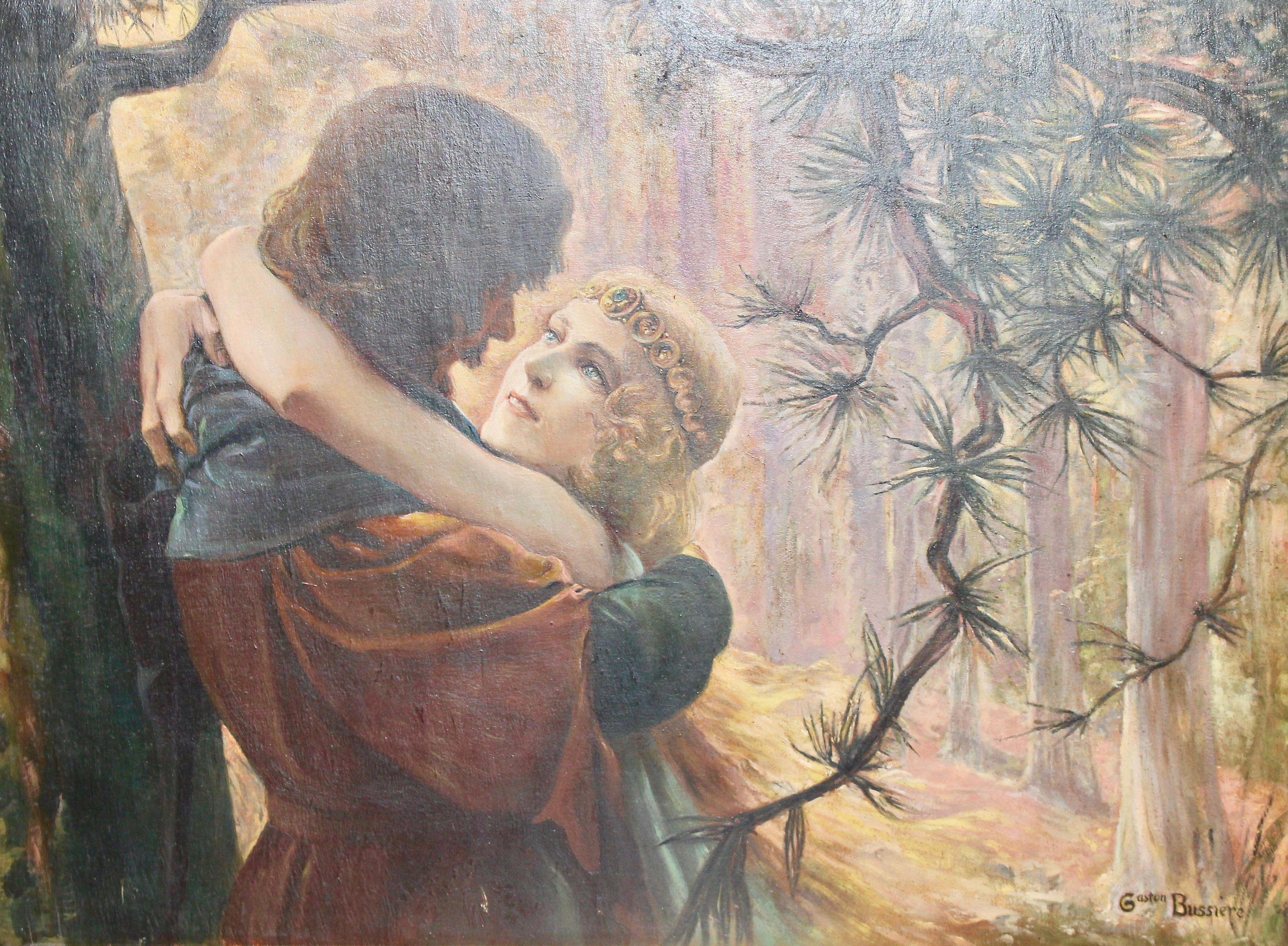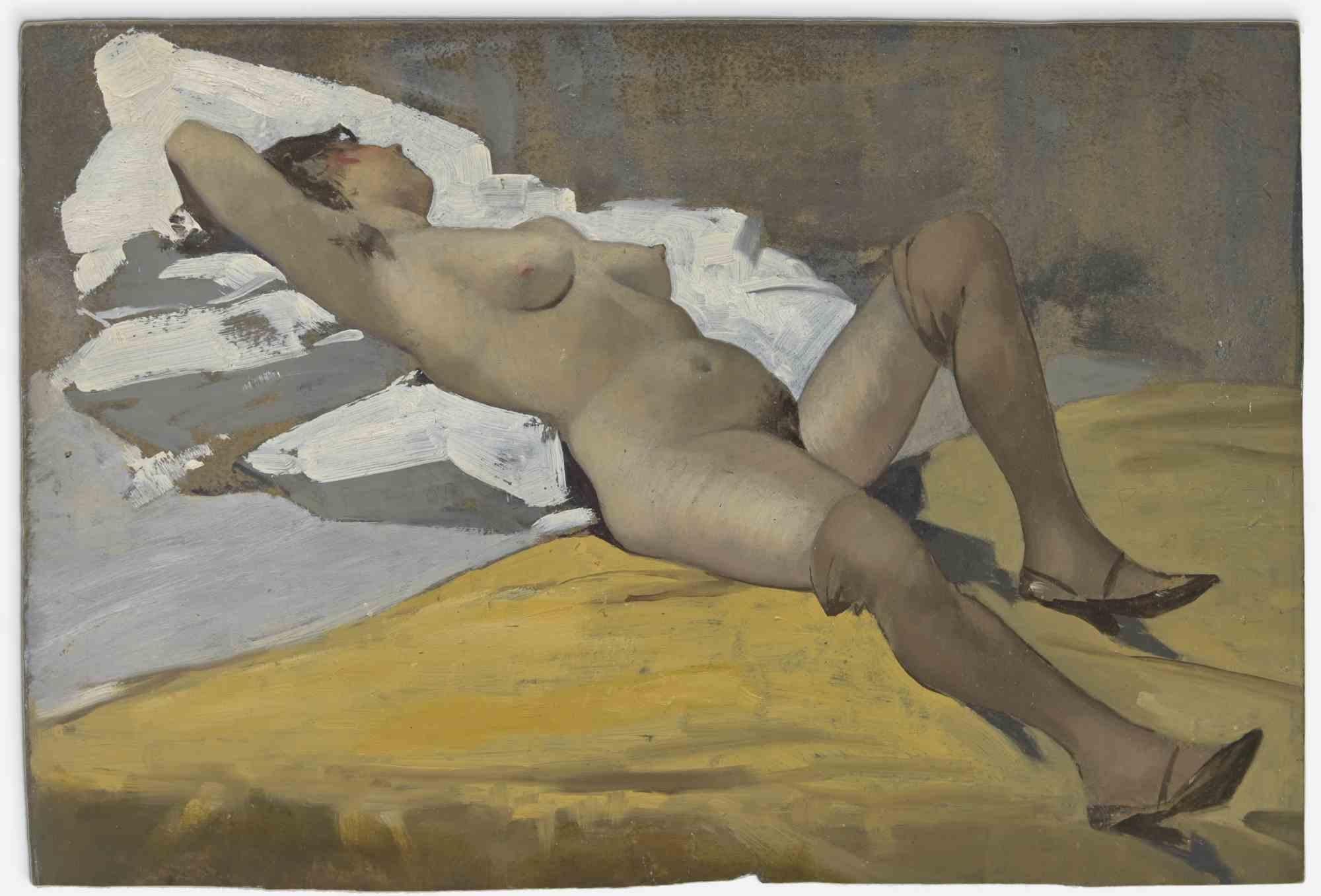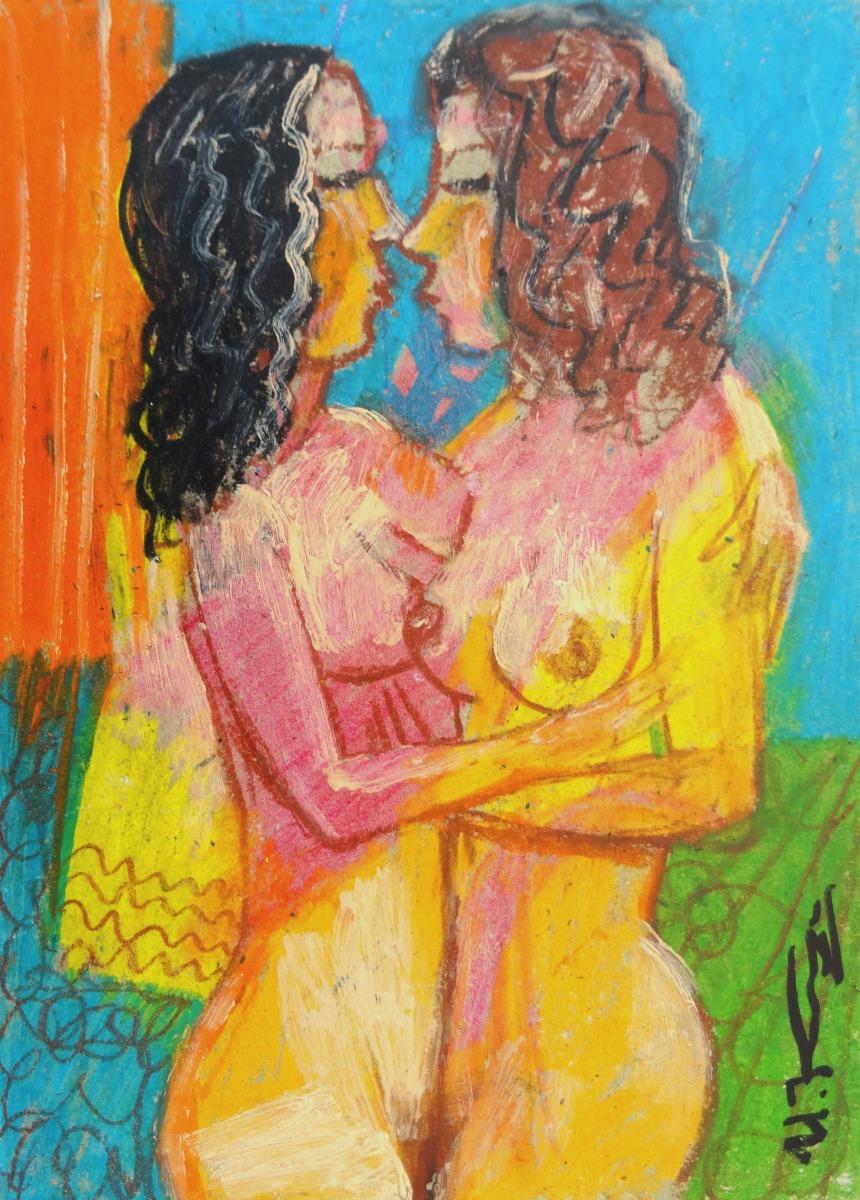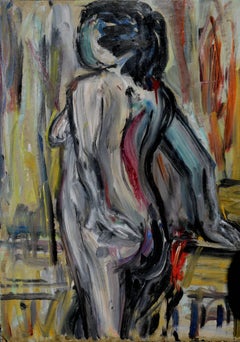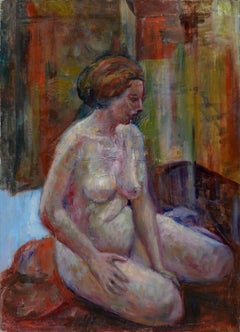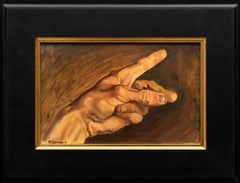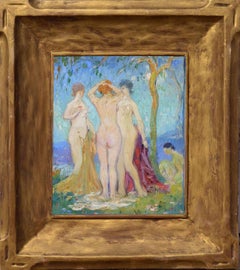
Nudes in the Garden, France - 1929 by Abel Warshawsky
View Similar Items
Want more images or videos?
Request additional images or videos from the seller
1 of 6
Abel WarshawskyNudes in the Garden, France - 1929 by Abel Warshawsky1929
1929
About the Item
- Creator:Abel Warshawsky (1883 - 1962, American)
- Creation Year:1929
- Dimensions:Height: 19 in (48.26 cm)Width: 2 in (5.08 cm)Depth: 16 in (40.64 cm)
- Medium:
- Movement & Style:
- Period:
- Condition:Some normal wear consistent with age.
- Gallery Location:Soquel, CA
- Reference Number:Seller: 247D1stDibs: LU542383602
About the Seller
5.0
Platinum Seller
These expertly vetted sellers are 1stDibs' most experienced sellers and are rated highest by our customers.
Established in 1986
1stDibs seller since 2014
2,510 sales on 1stDibs
More From This SellerView All
- Mid Century Bay Area Figurative Movement Nude StudyBy Honora BergLocated in Soquel, CANude study by Honora Berg (American, 1897-1985). Image, 26"H x 20"W on artsits cardboard. Signed/stamped "Estate of Honora Berg" on verso, from a collection of her works. Berg studied at the San Francisco Art Institute with David Park, Elmer Bischoff, and James Budd Dixon. Berg's friend Edith Truesdell...Category
1950s Abstract Expressionist Figurative Paintings
MaterialsOil, Cardboard
$1,720 Sale Price20% Off - Mid Century Sitting Nude FigurativeBy Elmer AlbrittonLocated in Soquel, CAMid Century figurative painting of a pensive sitting nude figure with moody, mid-century color palette in the background. Attributed to Elmer S. Albritton, unsigned (American, 1922-...Category
1960s American Modern Nude Paintings
MaterialsCanvas, Oil, Cardboard
$1,480 Sale Price20% Off - Nude Figure Study, Standing Female Figure with Sage GreenBy M. Z. MurphyLocated in Soquel, CANude Figure Study, Standing Female Figure with Sage Green Figure study of a nude model in studio by Los Gatos, California artist M.Z. Murphy (American, 20th century), c.1990. The f...Category
1990s American Impressionist Nude Paintings
MaterialsCanvas, Oil, Cardboard
- Nude Figure with StoolBy M. Z. MurphyLocated in Soquel, CAArtist's study of a model in studio by Los Gatos, California artist Maryanne Z. Murphy (American, 20th century). Signed with initials "MZM" lower right. Unframed. Image, 24"H x 18"L....Category
1990s Modern Nude Paintings
MaterialsCanvas, Cardboard, Oil
$720 Sale Price20% Off - Mid Century Abstract Expressionist Grey FigurativeBy Louis NadaliniLocated in Soquel, CAAbstract expressionist nude figure by Louis Nadalini (American, 1927-1995). Signed "Louis Nadalini" in the lower right corner. Signed "Louis Ernie Nadalini" on verso. Unframed. Image...Category
1980s Abstract Expressionist Nude Paintings
MaterialsCardboard, Canvas, Oil
$1,080 Sale Price20% Off - Dancers Waiting To Go On, Male FigurativeBy Marc Foster GrantLocated in Soquel, CAVivid and dynamic painting of two male figures preparing to go on stage by Marc Foster Grant (American, b. 1947). Titled "Dancers Waiting To Go On" lower left, and signed and dated "...Category
2010s Contemporary Figurative Paintings
MaterialsPaper, Oil, Cardboard
$636 Sale Price20% Off
You May Also Like
- Nandor Vagh Weinmann, Oil on cardboard, Naked Back, 1930sLocated in Saint Amans des cots, FROil on cardboard by Nandor VAGH WEINMANN (1897-1978), France, 1930s. Naked back. With frame: 64x56 cm - 25.2x22 inches ; without frame: 46x38cm - 18.1x15 inches. 8F format. Signed "Nandor V. Weinmann" lower left. In its Montparnasse frame. Very good condition. Born October 3, 1897 in Budapest, Nándor is the older brother of Elemer and Maurice Vagh-Weinmann. He came to Paris to present his work in 1931. He died on December 12, 1978 near Montereau (Seine-et-Marne) following an automobile accident. He is the most colorful of the three “expressionist” brothers. Painter of figures, landscapes, especially open mountains, and bouquets in bright colors. He is also a religious painter and then finds the tragic condition. Born in BUDAPEST on October 3, 1897, Nandor Vagh Weinmann belongs to a profoundly artistic people. Living in the heart of Central Europe where they came from Asia a millennium ago, the Hungarians have preserved a strong ethnic individuality whose mark is their very synthetic, non-Indo-European language. Resistant to secular invasions, they have kept the virtues of a very ancient humanity that have become rare in our modern world, especially since their way of life has remained essentially rural until today. In the arts they know how to express a generous, extreme sensibility and by the poetic verb, by the musical rhythms and also by a popular art of a richness, an exceptional harmony. Until the age of thirty-four, during the decisive years of childhood and youth, Nandor Vagh Weinmann was intimately imbued with popular life and the soul of Hungary. From the capital where his father was a jeweler and had a family of ten children, Nandor was the fifth, he knew first of all the suburbs, the populated districts, the rigors in winter of the cold and the snow. A very mobile existence made him acquainted with all of Hungary, from the Danube to Transylvania, its infinite plains and its wild mountains, its immense villages with ample low houses, and its towns which are still immense villages. The painter is passionate about rustic works, harvest scenes, beautiful folk costumes. Coming into direct contact with the peasants, he learned to know their soul. These contacts gave the artist a direct feeling for popular life and soul, as Millet once understood the peasants of Barbizon and Normandy whose existence he shared. What fascinated Nandor Vagh Weinmann above all were the festivals which enlivened the dreary life of the countryside, the circuses, the merry-go-rounds, the gypsies unleashing orgies of music, light and color. In the party, and especially the Hungarian party, the whole soul of a people, all its energy, its need for movement, for intensity, is expressed in its pure state and realizes the primary and essential form of what is called beauty. And as if melted at the party, there is the infinite steppe where herds of horses and oxen circulate where terrible storms sometimes roar where the seasons unfold their grandiose splendours. The young Nandor Vagh Weinmann nourishes his sensitivity to his inexhaustible shows, both eternal and always new, a sensitivity which very early declared itself that of a painter. Since the age of fourteen he painted, and since then he never stopped doing it. Two of his brothers Maurice, two years his junior, who had a remarkable career similar to that of Nandor and later Elemer who became Maurice's pupil, also devoted themselves to painting, despite family obstacles. And the three brothers united by a common passion worked together in Hungary and later in France. Painting was so much in the blood of the family, as in the past among the Veroneses, the Breughels, the Lenains, the Van Loos and so many other artistic dynasties, that three sons of the Vagh Weinmanns became painters in their turn. One of these, Emeric, son of Nandor, today occupies an important place in the contemporary school. Nandor, at fifteen, was a pupil of the Academy of Fine Arts in Budapest where he worked diligently, then at that of Vienna. He painted many portraits, but also landscapes, compositions and, by his relentless work, managed to live from his brush, although married very young and having to overcome many hardships. He therefore knew the hardships and miseries of life. These strongly impregnated his vision as an artist and explain the thrill of humanity that runs through all his work. A particularly moving experience was reserved for him at the age of twenty. In the hospitals of Budapest he had to paint extraordinary cases, operations, frightful wounds, the deformations to which our poor body is subjected by traumas and physiological decompositions. In these circumstances, it is not a question of gratuitous art, of formal research but of immediate, authentic expressions of our flesh and our being. We know that Breughel Velázquez and Goya had been haunted by the sight of cripples and of madmen Géricault by that of corpses. But life is ultimately stronger than anything, and it is life that Nandor Vagh Weinmann has passionately observed and translated through all the places where he has always painted on nature. Nothing stopped him. It happened to him to paint, for example in front of the mill of Linselles by a weather so cold, that nobody could stay outside, and that he did not leave the place before having finished his work. Because he works constantly on the ground, under the sky, in the silence he loves. His reputation is established. He exhibited at the national fair in Budapest, in the big cities of Hungary Szeged, Szombathely, Veszprém, Kaposvar. In 1931, like all artists in the world, he came to France. But unlike the others, he did not settle in Paris. Because Nandor Vagh Weinmann does not belong to this group of cosmopolitans that we call the School of Paris. He settled in Toulouse, where he remained for a long time with his brothers, and traveled throughout France, eager for new ties, exhibiting in the most diverse cities, in Bordeaux, Marseille, Lyon, Agen, Bayonne, Dax, Tarbes, Grenoble, Nice, Cannes, Strasbourg, Mulhouse, Colmar, Lille. He even crossed borders. He was in Saint Sebastian, in Geneva, and once in Egypt in 1927 where he painted King Fouad...Category
1930s Expressionist Figurative Paintings
MaterialsOil, Cardboard
- Morning. Women's act. 1959. Oil on cardboard, 95x71 cmBy Alfejs BromultsLocated in Riga, LVThe morning hour. Act. 1959. Oil on cardboard, 95x71 cm Alfejs Bromults (1913.3.IV - 1991.11.I) His first professional education was at National University at studies to R.Suta, J....Category
1950s Realist Nude Paintings
MaterialsCardboard, Oil
- 19th Century French Academic Study of a HandLocated in SANTA FE, NMFrench Academic Study of a Hand Circa 1900 Oil on Cardboard 13 3/8 x 8 3/8 (19 1/8 x 14 1/8 frame) inches Signed lower left "M. Granet" A very finely...Category
Early 1900s Realist Figurative Paintings
MaterialsOil, Cardboard
$2,750 Sale Price38% Off - Baigneuses en Bord de Rivière by Georges Manzana Pissarro - Nude paintingBy Georges Henri Manzana PissarroLocated in London, GB*UK BUYERS WILL PAY AN ADDITIONAL 5% IMPORT DUTY ON TOP OF THE ABOVE PRICE Baigneuses en Bord de Rivière by Georges Manzana Pissarro (1871-1961) Oil on cardboard 98.2 x 79.4 cm (38...Category
1910s Post-Impressionist Figurative Paintings
MaterialsOil, Cardboard
- Art Déco Painting, ca. 1910, oil on cardboard. Romantic love scene in the forestBy Gaston BussiereLocated in Berlin, DEPainting, around 1910, oil on cardboard. Romantic love scene in the forest. Signed, Gaston Bussiere. With beautiful (original) Art Deco frame. Frame has minimal damage in places. Dimensions with frame 67cm x 86cm This painting is offered here for the first time exclusively on 1stdibs! From private, German estate. Gaston Bussière (April 24, 1862 in Cuisery – October 29, 1928 or 1929 in Saulieu) was a French Symbolist painter and illustrator. Bussière studied at l'Académie des Beaux-Arts in Lyon before entering the école des beaux-arts de Paris where he studied under Alexandre Cabanel and Pierre Puvis de Chavannes. In 1884, he won the Marie Bashkirtseff...Category
1910s Symbolist Figurative Paintings
MaterialsOil, Panel, Cardboard
$22,826 Sale Price25% OffFree Shipping - Woman Lying Down on White Cloth - Oil Painting - Mid-20th CenturyLocated in Roma, ITWoman Lying Down on White Cloth is an artwork realized by an Italian Artist in mid-20th Century. Oil on cardboard 24x34 cm. Good conditions.Category
Mid-20th Century Modern Figurative Paintings
MaterialsCardboard, Oil
Recently Viewed
View AllMore Ways To Browse
Sharon Paris
Three Graces Oil Painting
Sharon France
Abel Warshawsky On Sale
Le Chateau
John Michel Basquiat
Oil Paintings White Dress
Water Illusion
Arrow Stand
Street Cafe
St Elizabeth
Chapel Oil Paintings
Large Male Painting
Oil Painting Mother Child
Modern Figurative Street Scene
Vintage Paintings Of Women
Figural Light Female
Us Money
